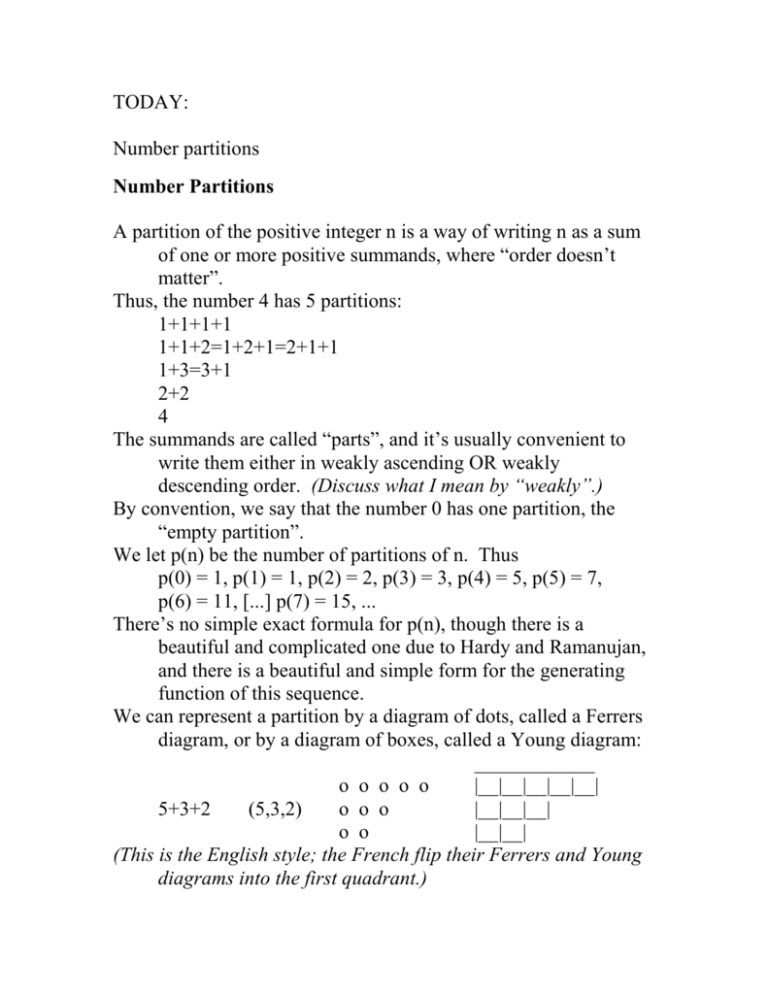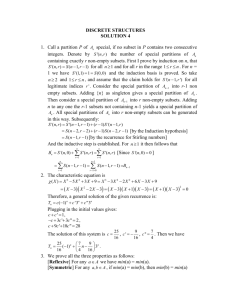Catalan numbers and triangulations
advertisement

TODAY:
Number partitions
Number Partitions
A partition of the positive integer n is a way of writing n as a sum
of one or more positive summands, where “order doesn’t
matter”.
Thus, the number 4 has 5 partitions:
1+1+1+1
1+1+2=1+2+1=2+1+1
1+3=3+1
2+2
4
The summands are called “parts”, and it’s usually convenient to
write them either in weakly ascending OR weakly
descending order. (Discuss what I mean by “weakly”.)
By convention, we say that the number 0 has one partition, the
“empty partition”.
We let p(n) be the number of partitions of n. Thus
p(0) = 1, p(1) = 1, p(2) = 2, p(3) = 3, p(4) = 5, p(5) = 7,
p(6) = 11, [...] p(7) = 15, ...
There’s no simple exact formula for p(n), though there is a
beautiful and complicated one due to Hardy and Ramanujan,
and there is a beautiful and simple form for the generating
function of this sequence.
We can represent a partition by a diagram of dots, called a Ferrers
diagram, or by a diagram of boxes, called a Young diagram:
____________
o o o o o
|__|__|__|__|__|
5+3+2
(5,3,2)
o o o
|__|__|__|
o o
|__|__|
(This is the English style; the French flip their Ferrers and Young
diagrams into the first quadrant.)
Put origin at lowest left vertex.
If a partition has B parts, and the largest part is A, then the Young
diagram has a boundary that consist of three parts: a straight
path from (0,0) to (0,B), a straight path from (0,B) to (A,B),
and a NE, SE, lattice path from (0,0) to (A,B) that begins
with an E-step and ends with an N-step.
If we drop the constraint that the lattice path has to begin with an
E-step and end with an N-step, we get all the partitions with
at most B parts, and with each part of size at most A.
Show how the partition (2,1) fits inside this diagram.
These are precisely the partitions whose Young diagram fits inside
an A-by-B rectangle.
The number of such partitions equals the number of lattice paths
from (0,0) to (A,B), namely (A+B)!/A!B!.
What if we want to “q-count” the partitions?
But wait: we already have!
(Discuss; point out that we’re complementing, but that it doesn’t
matter, because of the symmetry.)
Theorem (already proved): The number of partitions of n with at
most B parts, each of size at most A, is equal to the
coefficient of q^n in the polynomial [A+B]!/[A]![B]!
These polynomials are called the Gaussian polynomials, or the
q-binomial coefficients.
What happens when A or B goes to infinity, or both of them do?
Write [A+B]!/[A]![B]! = ([A+1]/[1])([A+2]/[2])...([A+B]/[B])
= ((1-q^{A+1})/(1-q)) ((1-q^{A+2})/(1-q^2)) ...
((1-q^{A+B})/(1-q^B))
If B goes to infinity, this goes to 1/(1-q)(1-q^2)...(1-q^A).
Consequence: The number of partitions of n into parts of size at
most A is equal to the coefficient of x^n in the formal power
series 1/(1-q)(1-q^2)...(1-q^A).
Note direct proof.
More generally: if S is any subset of the positive integers, the
number of partitions of n into parts belonging to S equals the
coefficient of x^n in the (finite or infinite) product
prod_{k in S} 1/(1-q^k).
What can you say about an exact formula for the number of
partitions of n into 2’s, 3’s and 5’s? ...
It is a ``quasi-polynomial function’’ (discuss) of n, of the form
f(n) = C_n n^2 + D_n n + E_n
where C_n, D_n, and E_n are periodic mod (2)(3)(5).
Equivalently, f(n) = p_n (n) where p_1, p_2, ... is a periodic
sequence of degree-2 polynomials with period 30.
The g.f. 1/(1-q)(1-q^2)...(1-q^m) also counts partitions with at
most m parts.
Partitions with exactly m parts:
1/(1-q)...(1-q^m) – 1/(1-q)...(1-q^{m-1}
= q^m/(1-q)...(1-q^m).
Mention bijective proof, too.
Partitions with largest part m: also q^m/(1-q)...(1-q^m).
Mention bijective proof.
Take A,B both to infinity: 1/(1-q)(1-q^2)(1-q^3)...
Let p(n) = # of partitions of n (unconstrained),
p(n,k) = # of partitions of n with largest part k.
Then p(n) = p(n,1) + p(n,2) + p(n,3) + ...
Claim: p(n,k) = p(n-k,k) + p(n-1,k-1) if 1 leq k leq n geq 0.
Proof: See Wilf, “East Side, West Side”.
OMIT:
Proof: p(n,k) – p(n-k,k) equals the number of partitions of n in
which
(A) the part k occurs exactly once and all other parts are
strictly smaller.
If we take such a partition and reduce its unique part of size k
by 1, we get a partition of n-1 in which
(B) the largest part is of size k-1.
Conversely, given a partition of n-1 satisfying (B), if we
increase one of its parts of size k-1 by 1, we get a partition of
n satisfying (A).
RESUME:
Wilf, in “East Side West Side”, goes on to turn this into a Maple
program, using suitable initial conditions.
The generating function for partitions into distinct parts is
(1+q)(1+q^2)(1+q^3)...
Explain.
The generating function for partitions into distinct parts with
exactly m parts is
q^{1+2+...+m} / (1-q)(1-q^2)...(1-q^m).
Explain.
Theorem (Euler): The number of partitions of n into distinct parts
equals the number of partitions of into odd parts.
Algebraic proof: (1+x)(1+x^2)(1+x^3)(1+x^4)...
1-x^2 1-x^4 1-x^6 1-x^8
= --------- --------- -------- --------- ...
1-x
1-x^2 1-x^3 1-x^4
= 1/(1-x)(1-x^3)(1-x^5)(1-x^7)...
Bijective proofs are also known.
Good challenge: find one!
The coefficient of x^n in (1+x^2)/(1–x^3) is the number of
partitions of n into parts of size 2 and 3, where the part
of size 2 cannot be repeated. Call it a_n.
The coefficient of x^n in (1-x^3)/(1+x^2) is the sum of the weights
of all the partitions of n into parts of size 2 and 3, where
the part of size 3 cannot be repeated, where the weight of a
partition is -1 to the power of the number of parts. Call the
coefficient b_n.
Claim: For n > 0, sum_{k=0}^n a_k b_{n-k} = 0.
Algebraic proof: Same as in last problem of midterm.
Good challenge: Find a bijective proof.
The long recurrence relation for p(n):
p(n) = p(n-1) + p(n-2) – p(n-5) – p(n-7) + p(n-12) + p(n-15)
– p(n-22) – p(26) + p(n-35) + p(n-40) – – + + ...
Equivalently:
Euler’s pentagonal number theorem:
(1-x)(1-x^2)(1-x^3)...
= sum_{n in Z} (-1)^n q^{3n(n+1)/2}.
Explain why it’s equivalent.
Franklin’s bijective proof:
Assign a partition with distinct part weight (-1)^k, where k is
the number of parts, so that the coefficient of x^n in the
LHS is the sum of the weights of the partitions of n into
distinct parts.
Say a partition with distinct parts is pentagonal if the parts are
m+1,m+2,...,m+n with n=m or m+1.
Claim: For all n, the sum of the weights of all the non-pentagonal
partitions of n into distinct parts equals 0.
Very tricky exercise: Find a sign-reversing involution. (The details
are in just about any treatment of partitions you could find.)
Give details, if time permits and the students desire.
OMIT: Uniqueness of cyclotomic factorization
OMIT: Durfee square
OMIT: Rogers-Ramanujan theorem (have them conjecture this?)
OMIT: HW: Fix m, and let f(n) be the number of partitions of n
into at most m parts. Since f is a quasi-polynomial, it is well
defined for all integers. Find a combinatorial interpretation
for f( ) at negative integers.
OMIT: HW: Count terms in coefficients in e^(x f(x))
OMIT: HW: have them conjecture 2nd R-R having seen the 1st









